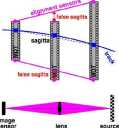7884079598


Figurę 1. Sagitta definition and
Figurę 2. ATLAS muon spectrometer optical alignment system.
optical linę schema.
delivering services to the alignment algorithms (and to client applications) in order to compute the chamber positions and deformations to be applied at the level of the reconstruction software.
2. The software chain of the optical Muon Alignment System
The alignment system has to follow muon spectrometer deformations in ąuasi real time to provide corrections in a few hours after the physics data have been taken. Figurę 3 shows schematically the software chain: the Online chain is deployed inside the ATLAS private network, while the offline chain is deployed inside CERN GPN (General Public Network).
2.1. The online side: read-out system and optical image analysis
Optical sensor images for the barrel system are collected from the read-out [3] software running on 8 data acąuisition PCs; a fuli read-out cycle is performed every 15 minutes (a similar schema is valid for the end cap system). Optical images are analyzed in order to compute a set of parameters related to displacements and rotations, which are stored in the Online Oracle DB cluster (ATONR).
The data are then replicated to the offline Oracle DB cluster (ATLR) inside the CERN GPN every few seconds, using Oracle Streams[4]. The migration to ATLR cluster is needed because alignment algorithms are running on GPN network, outside the private online network.
2.2. The offline side : alignment algorithm and monitoring seruer
The data collected by the online read-out system are used as input to alignment algorithms (called Asap for barrel, Aramys for the end-caps). These programs retrieve optical sensors data from Oracle and compute the corrections to nominał chamber positions over a given IOV (Interval Of Validity). The corrections are validated and uploaded to the ATLAS condition database (COOL [5]), for use by muon reconstruction software.
As we can see in figurę 3, the offline chain is madę of several software components:
1) The alignment monitoring server: Java software running inside a J2EE [6] compliant application server, providing access to the Oracle DB to persist configurations, bookkeeping of alignment corrections and monitoring data.
2) Alignment reconstruction software: Asap and Aramys.
3) Client libraries to access remotely the monitoring server for visuałization and data monitoring.
4) A python based web server, CherryPyCool [7]: a Restful service accessing COOL data via the COOL API, making that data available via standard GET, PUT ad POST HTTP methods.
Wyszukiwarka
Podobne podstrony:
image004 SPACE -FREOUENCY OVERTONES SPACE FREOUENCY t FIGURĘ 3 SPACE FREOUENCY SPECTRUM
A J2EE based server for Muon Spectrometer Alignment monitoring in the ATLAS detector Journal of
f2 38 Definitions and References Biowse Identifier: i- Select query: File OuŁline Base Classes and M
Jŕzykoznawstwo licencjat 2 Egzamin licencjacki Zagadnienia z zakresu językoznawstwaThe properties
High quality materiał, high definition and elear image, improving your work efficiency. The 37MP hig
1H4 Figurę 3-2. In the ESEM the vacuum system is divided into as many as five stages of in
04vcu02 Browse identifier: iCAboutDli Select query: Definitions and References File Out linę Base Cl
3 Figurę 3. Scheme of incoherent optical system for forming of implant shadow images with CCD camera
38,39 ou People in the hospital Match up the person with the correct definition and write your answe
31078 mus dev(7) 28 EARLE LIEDERMAN (Kneeling) and CHAS. ATLAS(Standing) in an artistic pose In this
więcej podobnych podstron